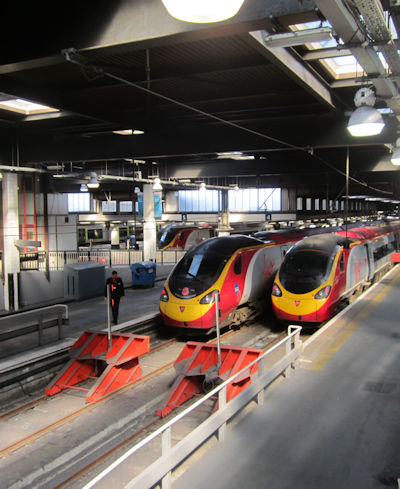Some people may be feeling left behind at UK news lately, so here is a summary.
Thursday 23rd June 2016
- Referendum is held on membership of European Union. Exit polls suggest a narrow Remain win.
Friday 24th
- UK wakes up to news that vote went to leave the EU by 17million votes to 15million;
- Pound collapses;
- Stock market plunges;
- Nigel Farage goes on ITV to deny that £350million promised by Leave battlebus for National Health Service will go anywhere near the National Health Service;
- Other notable Leave campaigners suggest continued single market presence and no cut in immigration;
- EU top brass ask for things to be tidied quickly;
- Leading Conservative Party “Leave” campaigners (Boris Johnson, ex Mayor of London, and Michael Gove, Justice Secretary) call on Prime Minister to stay on;
- David Cameron resigns as Leader of Conservative Party and announces intention to resign as Prime Minister when new leader is elected in October;
- Cameron kindly leaves triggering departure from the EU to his successor;
- Boris and Gove hold press conference where they stand around looking like they don’t really know what to do, weren’t expecting the result and have been steamrollered out of existence;
- Both suggest a period of calm and that there is no need to rush the result they had been anxiously fighting for;
- Scottish top brass say angry things;
- Boris is abused for his support for Leave.
Saturday 25th
- Angela Merkel, Chancellor of Germany, suggests that EU exit talks will be nice and friendly;
- Labour Party Leader Jeremy Corbyn, Leader of the Opposition, denies he is going to quit too as various people blame him for not delivering a Labour block vote for Remain.
Sunday 26th
- Jeremy Corbyn fires his Shadow Foreign Secretary Hillary Benn;
- Reports that half Corbyn’s top team will now resign feel overblown;
- Petition for a second EU referendum set up by a Leave supporter expecting to lose is overladen with support, some of it created by computer programmes written by people who fancied making computers repeatedly sign petitions;
- England win at rugby against Australia;
- 12 of Corbyn’s Shadow Cabinet members quit in protest at his continued leadership, including most of the people who voters might have heard of for moderately good reasons (and the woman who said that Ed Miliband carving his vacuous election pledges in a bit of stone last year didn’t mean he wasn’t going to break them).
Monday 27th
- Most of the rest of Corbyn’s Shadow Cabinet quits, leaving some of his mates, an ex-girlfriend, two people who can’t resign but promised to stop attending and a former party leadership contender whose attitudes bear a certain resemblance to a drowned sponge;
- Angela Eagle, one of those resigning, breaks down in tears on television;
- Corbyn recruits most of his remaining supporters/ people who would rather not have a Labour leadership contest to his Shadow Cabinet, filling roughly half the vacancies;
- Names include such widely-known figures as Pat Glass MP;
- Nick Clegg, once Liberal-Democratic Party leader and former Deputy Prime Minister, suggests an early election but is told by David Cameron that someone called Nick Clegg got a law passed about fixed-term Parliaments so he can’t go back to the country;
- Anti-foreign sentiment in UK post-referendum prompts concern;
- Corbyn heckled and told he faces a leadership contest at Labour party meeting;
- He goes to a rally of his supporters afterwards;
- Tory party reckons it should manage its leadership contest by 2nd September;
- England knocked out of Euro 2016 football tournament (by… err… Iceland);
- Panda gives birth to twins in China.
Tuesday 28th
- Nigel Farage, man who has done very little worth commenting on except complaining about the European Union and getting stuck in M4 traffic jams, accuses European Parliament members of having never had proper jobs;
- Pound continues to fall;
- Pat Glass MP decides she can’t face being MP for another term and tells her local party she will stand down at the next election;
- Jean-Claude Juncker, European Commission President, observes that people leaving the EU are, for obvious reasons, going to be outside the EU;
- Corbyn massively loses an unofficial vote of confidence in his leadership by 172 votes to 40;
- General feeling that nobody else from Corbyn’s cabinet will resign now.
Wednesday 29th
- Pat Glass MP resigns from Shadow Cabinet;
- Tory Party launches leadership contest. Anyone can stand if they can get two people to nominate them in 24 hours. Immediate appearance by Stephen Crabbe, Work and Pensions Secretary;
- Corbyn mocked at Prime Minister’s Questions and told to resign by Cameron;
- Gibralter begins looking at options for not totally uncoupling from the EU;
- It is announced that Angela Eagle will spend Thursday challenging Jeremy Corbyn for the Labour Party leadership.
Thursday 30th
- Theresa May, Liam Fox and Andrea Leadsom quietly launch Tory leadership campaigns;
- Michael Gove announces that despite years of not wanting to be Prime Minister and being totally unsuited to the role he regrettably considers it his duty to stand because Boris is incapable;
- Boris spends a press conference thought to be intended to launch his leadership bid, sets out his aims for the country and then closes by saying he won’t stand, leaving a distinct impression that he has given up on the premiership and his remaining political ambition is the Chiltern Hundreds;
- Gove has to spend the first bits of his leadership campaign explaining why he knifed Johnson in several places;
- The Eagle does not launch.
Friday 1st July
- Some debate over how to handle EU negotiations;
- Labour top brass reject calls for their party to back a second referendum or ignore the result of the first if they win any early election;
- George Osborne, Chancellor of the Exchequer, gives up on his delayed budget surplus targets;
- Wales goes through to the semi-finals of the Euro 2016 football tournament.
Saturday 2nd
- Shadow Cabinet look at ways to lever Corbyn out;
- Neil Kinnock tells Corbyn to go;
- Protest in London against democracy (specifically the referendum result).
Sunday 3rd
- Andrea Leadsom says we should get on with leaving the EU;
- Theresa May says there is no rush and people want a good prime minister for PM, not specifically a Brexiteer.
Monday 4th
- Nigel Farage resigns from UK Independence Party leadership – to jubilation from his Parliamentary party, who had a UKIP MPs meeting on Brexit arrangements and agreed unanimously with himself;
- Chris Evans resigns from his short-lived job hosting BBC2 show Top Gear – to jubilation from his predecessors, who were out in the sticks somewhere filming their new show for Amazon;
- Jeremy Corbyn does not resign – to the continued jubilation of his supporters;
- Foreign Secretary Philip Hammond says Theresa May is quite right not to guarantee EU citizen residency rights in UK (useful bargaining chip for British citizen residency rights in the EU and a general sign that the UK is reverting to the good old foreign policy approach that saw it sink the French fleet in 1940).
Tuesday 5th
- Teachers go on strike;
- Tory MPs vote on their leadership candidate preferences;
- Ken Clarke, former Chancellor of the Exchequer, is filmed making caustic remarks about “anyone but Gove” and how Theresa May is a “bloody difficult woman, but then you and I worked for Margaret Thatcher”;
- His interlocutor Malcolm Rifkind remarks that he and Ken would happily have had that conversation on the record if Sky had asked them to;
- Liam Fox knocked out of contest;
- Stephen Crabbe withdraws;
- Theresa May leads by some margin;
- Next round on Thursday;
- Twentieth anniversary of Dolly the Sheep, the first clone of an adult mammal.
Wednesday 6th
- Chilcot report into Iraq War published. Broadly speaking, Blair got carried away and deluded himself but with no dishonest intent;
- Tony defends himself;
- Wales knocked out of Euro 2016 tournament.
Thursday 7th
- Tony defends himself some more;
- Questions continue as to how much we want to leave the EU;
- Tony says world is a better place without Saddam;
- Gove supporters try to drum up support by suggesting that Andrea Leadsom, who hardly anyone had heard of a month or so previously, is not suitable leadership material;
- It is generally agreed that Tony Blair is probably not going to prison over Iraq;
- Ian Hislop spends a Question Time appearance arguing that just because Remain lost the referendum doesn’t mean it should be ignored forever more;
- Michael Gove, to the surprise of very few people, is knocked out of the Tory leadership contest;
- Tory party seems to generally incline towards his previous view that he is unsuited to be Prime Minister, and does not want him to put himself out unnecessarily;
- In the process of leaving he guarantees that the new Prime Minister will be a woman, for only the second time in the exceptionally long history of the Tory Party.
Friday 8th
- The actor who played Sulu in 1960s Star Trek is upset that Sulu has been outed as gay in the latest film (ironic, as Takei is also gay);
- Andrea Leadsom gives the Times an interview in which she says she won’t make the leadership contest about how she’s a mother and May isn’t because that would be “horrible” before going on to explain how as a mother she is making an investment in the future for her children.
Saturday 9th
- Andrea Leadsom sees the morning’s Times and takes issue with the headline saying that she thinks that as a mother she is making an investment in the future for her children;
- Italian foreign minister suggests UK might not leave the EU;
- Labour begins looking at nuclear deterrent options for its defence review;
- Tories announce plan to break up already wrecked Labour Party by having a vote on Trident renewal (which the Tories are largely in favour of, but Labour’s leader isn’t);
- The Eagle to fly on Monday;
- Still no candidate for UKIP leadership contest.
Sunday 10th
- Conservative Party wins general election (foreign news from Australia);
- Ongoing controversy over whether being a mother is a qualification for the role of Prime Minister, battering Leadsom in the process;
- John Prescott, once Tony Blair’s Deputy Prime Minister, announces the Iraq War to be illegal (some 13¼ years after he could have stopped it by resigning);
- Corbyn tries to calm critics by saying he voted to Remain;
- Chris Evans backs American co-host Matt LeBlanc to anchor next series of Top Gear;
- Andy Murray wins Wimbledon.
Monday 11th
- Theresa May goes to Birmingham to make a speech about why she should be Tory leader;
- Angela Eagle gets all the nation’s political press into a room to announce her Labour leadership bid;
- This means the Press all discover simultaneously that they want to be over at Andrea Leadsom’s house, where she is coming onto her doorstep to announce the end of her leadership bid;
- Eagle finishes her speech, turns to questions and finds the BBC, ITV, Channel 4 and Sky political editors have all run away;
- Leadsom says she can’t be leader without more support from the Parliamentary party [and a vastly thicker skin] and wishes May success as sole remaining Tory leadership candidate;
- May has achieved this mostly by making a joke about Boris buying water cannon and not self-immolating;
- Southern Railway cancels 341 trains from its timetable so that customers have some idea of what’s not going to run while it finishes managing the Government’s dispute with a trade union;
- Tory Party backbencher leader Graham Brady, technically the Chair of the 1922 Committee, announces that there need to be some internal discussions as to how to manage a leadership contest with one candidate;
- Discussions conclude Theresa May is the winner;
- Labour put out two press releases almost simultaneously, one demanding an immediate General Election and the other announcing a leadership election between two candidates of such polar opposites that they would be unable to agree a manifesto;
- Cameron comes out of No. 10 Downing Street to announce he will be resigning as Prime Minister after Prime Minister’s Questions on the 13th and expects to be replaced by Theresa May, after which he goes back inside humming the opening chords of “Braid the Raven Hair” from The Mikado.
Tuesday 12th
- David Cameron hosts his final Cabinet meeting;
- Angela Eagle’s office is vandalised;
- Jeremy Corbyn appeals for calm and for him to be on the Labour leadership ballot paper without needing to seek nominations;
- Neil Kinnock repeats previous observations that when Corbyn’s mate Tony Benn stood against him for the leadership in the 1980s Kinnock had to scuttle round for nominations;
- Petition on second EU referendum to be debated on 5th September in Parliament;
- Bernie Sanders backs Hillary Clinton as the Democratic candidate for President of the United States of America after a contest that began a year or so ago;
- Jeremy Corbyn is announced to be on the ballot for the Labour leadership without needing nominations.
Wednesday 13th
- Sun headline is about the BBC “faking” a “live” TV programme about trains by featuring a bit of film submitted by a viewer that was taking in February, thereby getting a picture of a Class 66 on the front of a national paper;
- The Japanese Emperor announces he intends to abdicate;
- The Prime Minister David Cameron lays into Labour for not being able to decide the rules of their leadership contest in the time it’s taken the Tories to have a leadership contest, praises Theresa May, claims he doesn’t hate the Downing Street cat, makes a speech thanking everyone in front of TV cameras, aides, his children and SamCam, goes to Buckingham Palace and quits;
- Theresa May goes to Buckingham Palace and accepts an invitation to form a Government;
- The Prime Minister Theresa May makes shorter speech than Cameron’s outside No.10 which doesn’t so much park tanks on Labour’s lawn as blow up their house, ransack the garden and build a new garden wall that confines the Opposition to the compost heap;
- Speech is noted as being rather like the one Ed Miliband would probably have made if he won last year’s election;
- Labour is too busy discussing if Pontypridd MP Owen Smith should be on the leadership election ballot paper to notice;
- The Mays refuse demands from the Press to kiss on live international television;
- George Osborne is encouraged to resign before he can outstay his welcome;
- New Government appointed with Philip Hammond as Chancellor (he was Osborne’s Shadow Chief Secretary to the Treasury until May 2010, when David Lawes got the full job and Hammond was banished to Transport), Boris as Foreign Secretary (he could have been Prime Minister in three years’ time if he’d backed Remain), Amber Rudd as Home Secretary and David Davis (not the MP for Monmouth) as Secretary of State for Leaving the European Union.
Note for Posterity
The above all actually happened and occurred in the timeframe specified.
Remaining points
One question remains. David Cameron had a house of his own in London which was tenanted. The tenants have apparently been given notice.
We have not heard enough about these tenants.
Did they know who their landlord was? If they did, they have presumably been packing since Friday 24th.
If not, one can picture them cheering his resignation when the phone rings.
“Sorry,” says the estate agent, “I’m afraid you’ve been given notice. Landlord needs his house back.”
“Why?!”
“He’s got to leave his place in a hurry after he quit his job.”
“What job was that?”
“Prime Minister.”
And finally…
Here is a mid-winter picture of a bridge in Maidenhead, our new Prime Minister’s constituency:
Maidenhead is one of the richest constituencies in the country. Jerome described the town as “too snobby to be pleasant” but added that the stretch of the Thames up to Cookham is “unbroken loveliness … perhaps, the sweetest stretch of all the river”.
Of course our previous Prime Minister was based in Witney, incorporating Charlbury and Hanborough, on the North-western side of Oxford.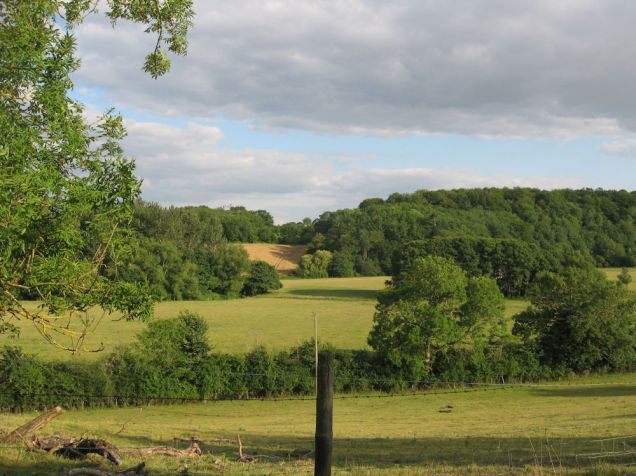
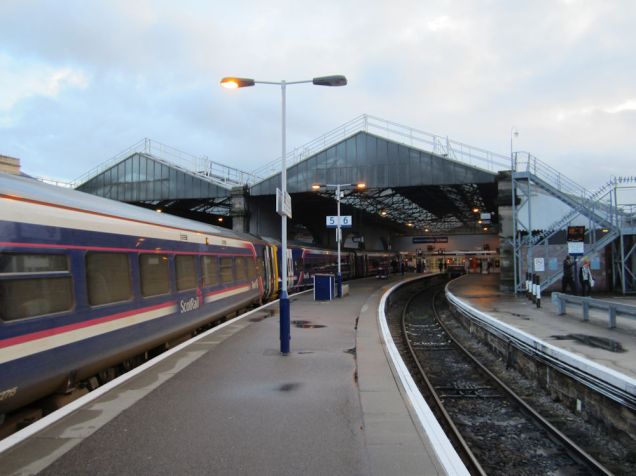 Inverness station, North Highland platform. A 4-car 158 sits in platform 5 – 158705 is nearest, looking grubby, with 158717 behind quietly gleaming. Between them they form the 17:54 Sundays-excepted “for Wick ‘n’ Thurso and Kyle o’ Lochalsh. Passengers for Wick ‘n’ Thurso should travel in the front two coaches and in the rear two coaches for Kyle o’ Lochalsh. Passengers travelling to Beauly this evening will need to alight from the front door of the second coach.” The Beauly part of the announcement, now augmented by Conon Bridge, almost adds to the interest of this train into the far distant wilds of Northern Scotland; both stations have platforms about 50ft long. The 17:54 used to divide at Dingwall, with the Wick portion striking on into the North and the Kyle portion then trundling Westwards. No more – Wick now has its own departure a full half-hour later and the 17:54 is for Kyle only.
Inverness station, North Highland platform. A 4-car 158 sits in platform 5 – 158705 is nearest, looking grubby, with 158717 behind quietly gleaming. Between them they form the 17:54 Sundays-excepted “for Wick ‘n’ Thurso and Kyle o’ Lochalsh. Passengers for Wick ‘n’ Thurso should travel in the front two coaches and in the rear two coaches for Kyle o’ Lochalsh. Passengers travelling to Beauly this evening will need to alight from the front door of the second coach.” The Beauly part of the announcement, now augmented by Conon Bridge, almost adds to the interest of this train into the far distant wilds of Northern Scotland; both stations have platforms about 50ft long. The 17:54 used to divide at Dingwall, with the Wick portion striking on into the North and the Kyle portion then trundling Westwards. No more – Wick now has its own departure a full half-hour later and the 17:54 is for Kyle only. The twinkling lights of Edinburgh from the Salisbury Crags during my first visit to the city. It was the farthest North I’d ever been at the time (my previous record was Carlisle). The excitement and interest was in some regards tamed by being there with friends for the Edinburgh Festival Fringe. Aside from the Fringe providing structure to proceedings, there is that little mite extra excitement for going somewhere miles off one’s beaten track for the first time with no company to anchor it to previous experience.
The twinkling lights of Edinburgh from the Salisbury Crags during my first visit to the city. It was the farthest North I’d ever been at the time (my previous record was Carlisle). The excitement and interest was in some regards tamed by being there with friends for the Edinburgh Festival Fringe. Aside from the Fringe providing structure to proceedings, there is that little mite extra excitement for going somewhere miles off one’s beaten track for the first time with no company to anchor it to previous experience. Druimuachdar Pass, highest point on the UK rail network. A key landmark on the run up to Inverness from Perth. Later the train clambers over Slochd summit and then coasts downhill into Inverness; sea level is reached at the beginning of Inverness station throat. My journey over here had the extra frisson that every yard the train pushed northwards was another yard further north on my personal map of the world.
Druimuachdar Pass, highest point on the UK rail network. A key landmark on the run up to Inverness from Perth. Later the train clambers over Slochd summit and then coasts downhill into Inverness; sea level is reached at the beginning of Inverness station throat. My journey over here had the extra frisson that every yard the train pushed northwards was another yard further north on my personal map of the world.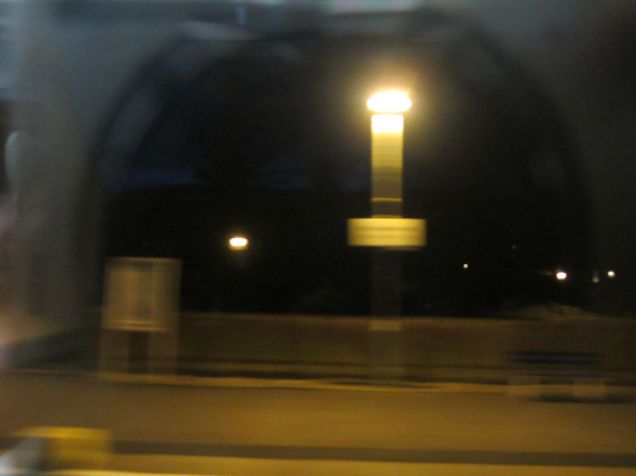 Unfortunately I did the holiday in October. Or perhaps not unfortunately, for as well as the excitement from having no company to anchor me to previous experiences there was also the interest from not having seen any of the last two hours of train journey to anchor me to the world I had come from. What little evidence of progress there was through the dark skies of Ross-shire in our rather lost little “158” came from the automated announcements as we passed the pools of light that marked intermediate stations only known to me from books and the slightly historical Driver’s Eye View Skye Train. “This is Achnasheen,” said the computerised Scottish lady, as we halted somewhere on a bit of moorland. “This train is for Kyle of Lochalsh. The next stop is Achnashellach.”
Unfortunately I did the holiday in October. Or perhaps not unfortunately, for as well as the excitement from having no company to anchor me to previous experiences there was also the interest from not having seen any of the last two hours of train journey to anchor me to the world I had come from. What little evidence of progress there was through the dark skies of Ross-shire in our rather lost little “158” came from the automated announcements as we passed the pools of light that marked intermediate stations only known to me from books and the slightly historical Driver’s Eye View Skye Train. “This is Achnasheen,” said the computerised Scottish lady, as we halted somewhere on a bit of moorland. “This train is for Kyle of Lochalsh. The next stop is Achnashellach.”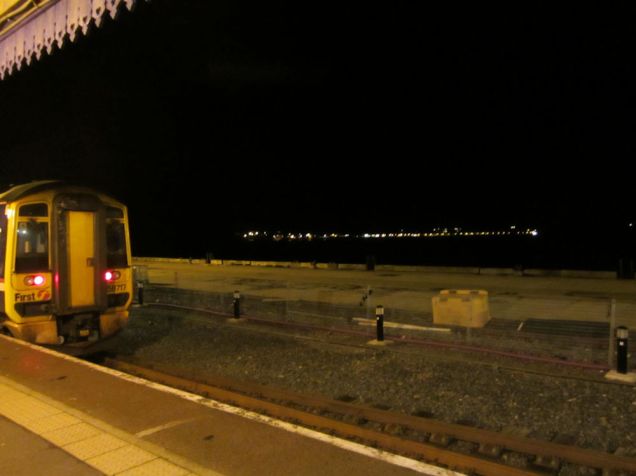 This was therefore my first view of Kyleakin, when 158717 had brought the 17:54 safely to its remote destination. For the Kyleakin-bound traveller, the Skye Mainline train wends down the side of Loch Carron, cuts through a promontory and pushes out into Loch Alsh before announcing it’s going no further and you’re on your own. The crew then add emphasis to this by turning off the engines and locking the “158” up for the night. It is a pleasant 45-minute walk from Kyle of Lochalsh station to Kyleakin, which adds a further certain frisson of adventure when done in the dark. A pavement follows the road all the way over to Skye.
This was therefore my first view of Kyleakin, when 158717 had brought the 17:54 safely to its remote destination. For the Kyleakin-bound traveller, the Skye Mainline train wends down the side of Loch Carron, cuts through a promontory and pushes out into Loch Alsh before announcing it’s going no further and you’re on your own. The crew then add emphasis to this by turning off the engines and locking the “158” up for the night. It is a pleasant 45-minute walk from Kyle of Lochalsh station to Kyleakin, which adds a further certain frisson of adventure when done in the dark. A pavement follows the road all the way over to Skye.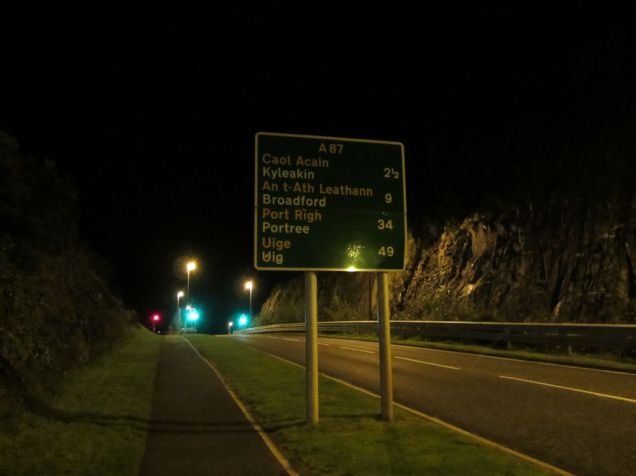 Journey’s end not yet reached, but Kyle of Lochalsh is the last place on the A87 on the British mainland. The road out of Kyle was built with the Skye Bridge in 1996, hence its relatively modern appearance. Until the bridge came, traffic was routed down the side of Kyle station to the ferry loading point for the crossing of the Kyle Akin, at the head of Loch Alsh, to Skye’s heather and mountains.
Journey’s end not yet reached, but Kyle of Lochalsh is the last place on the A87 on the British mainland. The road out of Kyle was built with the Skye Bridge in 1996, hence its relatively modern appearance. Until the bridge came, traffic was routed down the side of Kyle station to the ferry loading point for the crossing of the Kyle Akin, at the head of Loch Alsh, to Skye’s heather and mountains.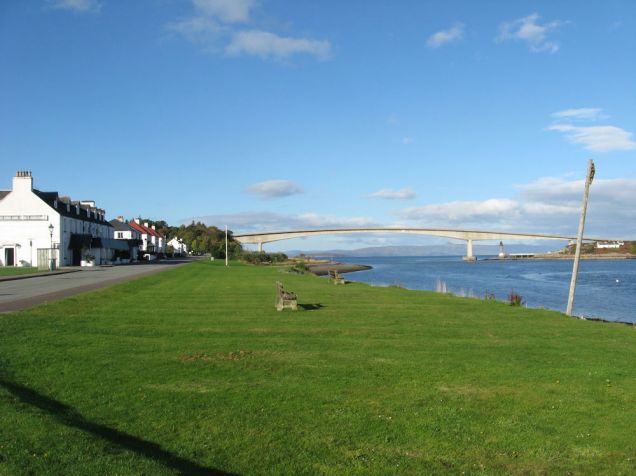 Daylight brings sight of Kyleakin properly after a chance to get enough sleep to appreciate it. I arrived in Morar in the same sort of conditions 18 months later; it’s my preferred way to begin a holiday when the last leg is fairly simple and the journey long. Between the main road and the kyle is a pleasing village green, overlooked by hostels, hotels and private housing. Beyond is the vast form of the arching Skye Bridge, carrying the A87 from mainland to island; occasionally views are expressed that Skye barely constitutes an island when you can drive onto it in a few seconds. For me, stepping onto the bridge was the first time I had been off the British mainland in three years; hardly an emotional moment, but a notable one all the same. The little island to the right, once an isolated scrap of rock carrying a small cottage only accessible by water, is now the support for a trunk road. It is notable for something; I forget precisely what.
Daylight brings sight of Kyleakin properly after a chance to get enough sleep to appreciate it. I arrived in Morar in the same sort of conditions 18 months later; it’s my preferred way to begin a holiday when the last leg is fairly simple and the journey long. Between the main road and the kyle is a pleasing village green, overlooked by hostels, hotels and private housing. Beyond is the vast form of the arching Skye Bridge, carrying the A87 from mainland to island; occasionally views are expressed that Skye barely constitutes an island when you can drive onto it in a few seconds. For me, stepping onto the bridge was the first time I had been off the British mainland in three years; hardly an emotional moment, but a notable one all the same. The little island to the right, once an isolated scrap of rock carrying a small cottage only accessible by water, is now the support for a trunk road. It is notable for something; I forget precisely what.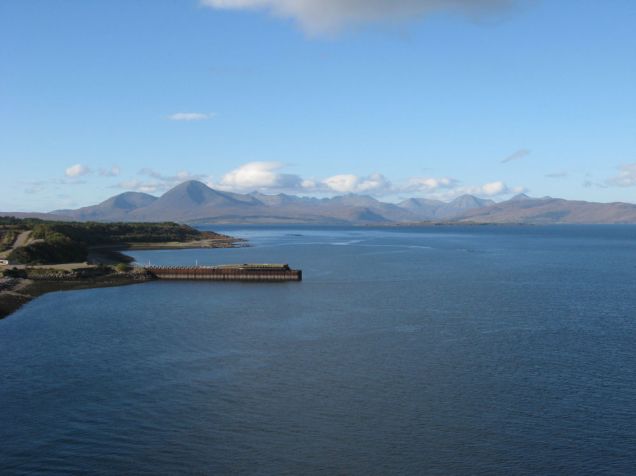 To the North are the Red Cuillins, which make up the backbone of this part of Skye, and the insignificant low-lying islet of Pabay which measures perhaps one square mile. Between us and the glacier-ridden form of Beinn na Caillich is the township of Broadford, out of view behind a small promontory to the left – a ribbon development along the A87 as it heads deeper into Skye. Broadford is also the junction for the A851 to Armadale. While the ferry at Kyleakin has gone, the ferry at Armadale still runs across the water to Mallaig. Mallaig has direct road and rail access to Fort William and Glasgow, but the voyage across the Sound of Sleat is much longer than that across Loch Alsh. The air is very clear in this part of Scotland and to those used to the more polluted atmosphere of Southern England distances can be very deceptive. The mountain is about 10 miles away and rises in a sheer sort of way to 732 metres. Curiously, despite it being usual in this area for things that are several miles away to appear to be a nice short walk, the submarine HMS Astute got everything the other way about in misjudging distances and collided with Skye in this general vicinity shortly after launching in 2010. It conjured up pleasing images of masses of foreign spies realising they could get a look at a world-leading submarine in a comparatively accessible location and crowding on the pierhead at Kyle with binoculars. Kyle of Lochalsh was one proposed base for the UK nuclear deterrent, but what with one thing and another it went to Faslane instead.
To the North are the Red Cuillins, which make up the backbone of this part of Skye, and the insignificant low-lying islet of Pabay which measures perhaps one square mile. Between us and the glacier-ridden form of Beinn na Caillich is the township of Broadford, out of view behind a small promontory to the left – a ribbon development along the A87 as it heads deeper into Skye. Broadford is also the junction for the A851 to Armadale. While the ferry at Kyleakin has gone, the ferry at Armadale still runs across the water to Mallaig. Mallaig has direct road and rail access to Fort William and Glasgow, but the voyage across the Sound of Sleat is much longer than that across Loch Alsh. The air is very clear in this part of Scotland and to those used to the more polluted atmosphere of Southern England distances can be very deceptive. The mountain is about 10 miles away and rises in a sheer sort of way to 732 metres. Curiously, despite it being usual in this area for things that are several miles away to appear to be a nice short walk, the submarine HMS Astute got everything the other way about in misjudging distances and collided with Skye in this general vicinity shortly after launching in 2010. It conjured up pleasing images of masses of foreign spies realising they could get a look at a world-leading submarine in a comparatively accessible location and crowding on the pierhead at Kyle with binoculars. Kyle of Lochalsh was one proposed base for the UK nuclear deterrent, but what with one thing and another it went to Faslane instead. Kyleakin’s main road runs down a promontory into the loch, to the right of this picture. Behind this promontory is the mouth of a stream called the An t-Ob; the landmass to the left being called the South Obbe. A bridge crosses the An t-Ob (with impressive water flows beneath at low tide) and the lane leads on down the north edge of the South Obbe past another dozen houses. Looking upstream provides a lovely little dell, with the foothills of one of Skye’s mountains in the background – this foothill being the Cnoc a Mhadaidh-ruaidh.
Kyleakin’s main road runs down a promontory into the loch, to the right of this picture. Behind this promontory is the mouth of a stream called the An t-Ob; the landmass to the left being called the South Obbe. A bridge crosses the An t-Ob (with impressive water flows beneath at low tide) and the lane leads on down the north edge of the South Obbe past another dozen houses. Looking upstream provides a lovely little dell, with the foothills of one of Skye’s mountains in the background – this foothill being the Cnoc a Mhadaidh-ruaidh.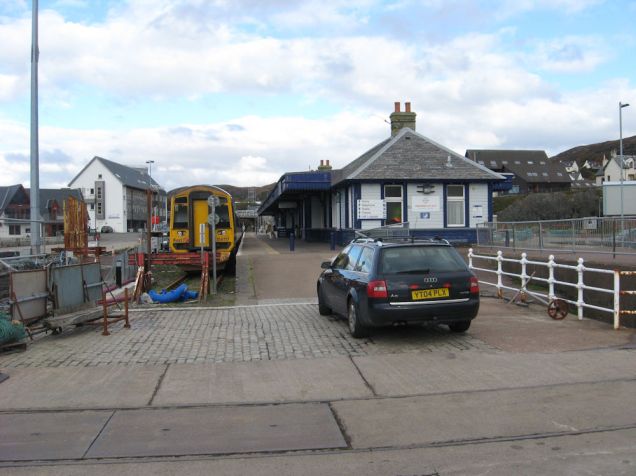 Daylight, and we return to the mainland to see Kyle of Lochalsh station from its unattractive end, looking north. Trips to Kyle while doing self-catering holidays in Kyleakin are fairly essential, as Kyle has the area’s Co-op (though Kyleakin has a corner shop that can fulfil some needs). At 5.72 degrees west and pointing almost due south, the station indicates towards a point just the slightest smidgen of a degree further west than Land’s End. The summer Sunday timetable gives Kyle two round trips, one starting at Kyle and the other at Inverness. The winter timetable simply withdraws the Kyle trip and the unit that arrived at Kyle on Saturday night remains there until Monday morning. The Inverness trip uses platform 2, to the right, with the peculiar consequence that the station appears at its busiest on Sundays out of season. 158717 is doing the honours on this particular Sunday morning after ferrying me in the night before. The station has an exposed feel in the middle of the loch, though is extensively sheltered by Skye. It is still interesting to ponder what the 158s make of this treatment, particularly in the depths of winter. The end of the running line represents one of the farthest extremes of the British rail network; being on the end of a pier in a loch gives it a finality lacked by land-based places like Mallaig, Penzance, Lowestoft (farthest east) or indeed Wick and Thurso. Stranraer is probably the nearest comparator. Kyle’s large station building is now a cafe, museum and ticket office. Beyond it a ramp leads up to the road bridge that carries the A87 over the platform. This ramp acts as access route, station car park, drop off area and anything else that it happens to be needed for. In the foreground is the remains of one of the pier’s sidings, accessed by wagon turntables, which allowed goods to be transshipped to onward ferries. As well as Skye, the station was also once the port for Stornaway on Lewis. This was regrettably transferred to Ullapool in the 1970s – shortening the crossing, but as a 1940s plan to build a branch from the Kyle line at Garve to Ullapool never came to fruition rail access is a trifle more difficult.
Daylight, and we return to the mainland to see Kyle of Lochalsh station from its unattractive end, looking north. Trips to Kyle while doing self-catering holidays in Kyleakin are fairly essential, as Kyle has the area’s Co-op (though Kyleakin has a corner shop that can fulfil some needs). At 5.72 degrees west and pointing almost due south, the station indicates towards a point just the slightest smidgen of a degree further west than Land’s End. The summer Sunday timetable gives Kyle two round trips, one starting at Kyle and the other at Inverness. The winter timetable simply withdraws the Kyle trip and the unit that arrived at Kyle on Saturday night remains there until Monday morning. The Inverness trip uses platform 2, to the right, with the peculiar consequence that the station appears at its busiest on Sundays out of season. 158717 is doing the honours on this particular Sunday morning after ferrying me in the night before. The station has an exposed feel in the middle of the loch, though is extensively sheltered by Skye. It is still interesting to ponder what the 158s make of this treatment, particularly in the depths of winter. The end of the running line represents one of the farthest extremes of the British rail network; being on the end of a pier in a loch gives it a finality lacked by land-based places like Mallaig, Penzance, Lowestoft (farthest east) or indeed Wick and Thurso. Stranraer is probably the nearest comparator. Kyle’s large station building is now a cafe, museum and ticket office. Beyond it a ramp leads up to the road bridge that carries the A87 over the platform. This ramp acts as access route, station car park, drop off area and anything else that it happens to be needed for. In the foreground is the remains of one of the pier’s sidings, accessed by wagon turntables, which allowed goods to be transshipped to onward ferries. As well as Skye, the station was also once the port for Stornaway on Lewis. This was regrettably transferred to Ullapool in the 1970s – shortening the crossing, but as a 1940s plan to build a branch from the Kyle line at Garve to Ullapool never came to fruition rail access is a trifle more difficult.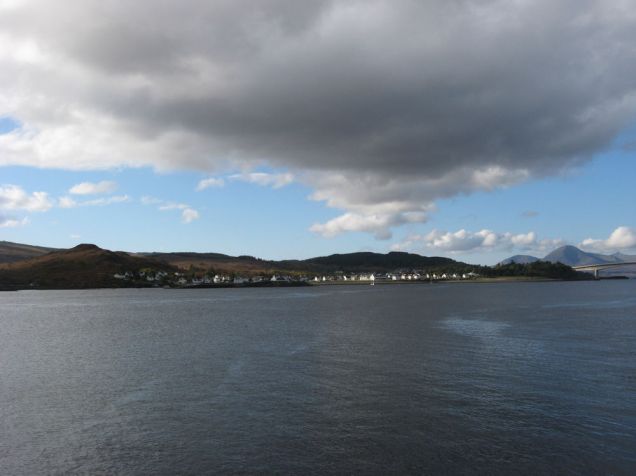 From the same point as above, looking the other way across the water. The headland of South Obbe squats to the left; Beinn na Caillich is off to the right behind the Skye Bridge. In between is the white strip of properties that make up Kyleakin, with the wooded headland hiding Kyle House and the landing point for the bridge.
From the same point as above, looking the other way across the water. The headland of South Obbe squats to the left; Beinn na Caillich is off to the right behind the Skye Bridge. In between is the white strip of properties that make up Kyleakin, with the wooded headland hiding Kyle House and the landing point for the bridge. Another overall view of Kyleakin, this time from Caisteal Maol to the east of the village. The main road curves across the green and then sweeps around the front of the houses on the promontory, finishing on the pier to the right. Parked on it was a minibus calling for something about Libya. The bridge again dominates the background scene. It was built as a private finance initiative and tolled accordingly (£5 single for a bridge maybe half a mile long), with the result that one of the first acts of the Scottish Government on getting transport devolved was to buy out the concession holder. This cost a similar price to building the bridge in the first price. Running a new concrete bridge not being a very extravagant affair, most of the £33million taken in tolls during the intervening 9 years presumably went in someone’s profits. The station museum has up a list of excuses for refusing to pay the tolls, but my favourite story is that agricultural traffic went over free so someone established a nice sideline leasing sheep for people to carry over the bridge in their cars. By the time I reached the area all that remained of the toll booths was a widening in the road, but the tourist board and all accommodation providers remained very keen to emphasise that the tolls had gone.
Another overall view of Kyleakin, this time from Caisteal Maol to the east of the village. The main road curves across the green and then sweeps around the front of the houses on the promontory, finishing on the pier to the right. Parked on it was a minibus calling for something about Libya. The bridge again dominates the background scene. It was built as a private finance initiative and tolled accordingly (£5 single for a bridge maybe half a mile long), with the result that one of the first acts of the Scottish Government on getting transport devolved was to buy out the concession holder. This cost a similar price to building the bridge in the first price. Running a new concrete bridge not being a very extravagant affair, most of the £33million taken in tolls during the intervening 9 years presumably went in someone’s profits. The station museum has up a list of excuses for refusing to pay the tolls, but my favourite story is that agricultural traffic went over free so someone established a nice sideline leasing sheep for people to carry over the bridge in their cars. By the time I reached the area all that remained of the toll booths was a widening in the road, but the tourist board and all accommodation providers remained very keen to emphasise that the tolls had gone.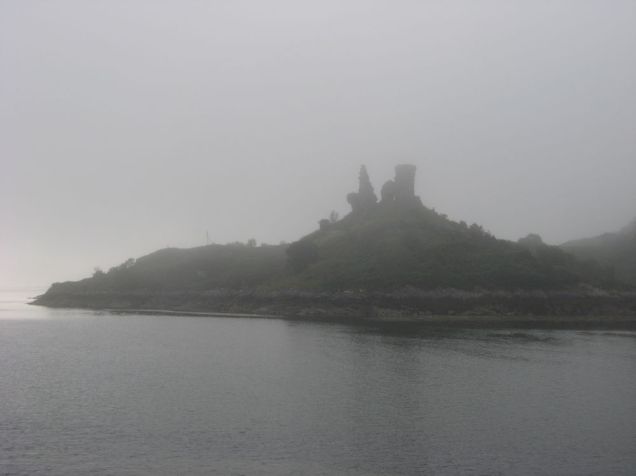 Moyle Castle/ Caistell Maol rises out of a summer mist on Loch Alsh, seem from the ferry slipway. The castle was never more than a single tower guarding the loch, more for the purposes of extorting passers-by than defending against enemies. A combination of dereliction and the local weather means that not a great deal is left, but it makes a suitably moody starring feature of this sort of picture.
Moyle Castle/ Caistell Maol rises out of a summer mist on Loch Alsh, seem from the ferry slipway. The castle was never more than a single tower guarding the loch, more for the purposes of extorting passers-by than defending against enemies. A combination of dereliction and the local weather means that not a great deal is left, but it makes a suitably moody starring feature of this sort of picture. A rather cheerier autumnal day, with the birds flying around the ruined castle and its heather-covered hill reflected in the bright blue waters of Loch Alsh beneath a clear sky. Note the tide marks. This is a particularly restful scene and the photo is one of which I am particularly fond.
A rather cheerier autumnal day, with the birds flying around the ruined castle and its heather-covered hill reflected in the bright blue waters of Loch Alsh beneath a clear sky. Note the tide marks. This is a particularly restful scene and the photo is one of which I am particularly fond. The loch stretches inland from the castle, which frames it nicely. The little lighthouse visible on the jutting rock centre left is on the island of Eileanan Dubha. A few miles up the loch a narrow passage off to the right called Kyle Rhea separates Skye from the mainland by a few hundred yards; it is spanned by a seasonal ferry near the hamlet of Kylerhea and leads on out into the Sound of Sleat past Mallaig and towards the Small Isles. At the head of Loch Alsh, just hidden by the headland of Avernish, is the restored castle at Eilean Donan. I have a rather nice painting of this on my wall (picked up at Tintern a year or so ago) but have to quietly cough when visitors ask if I’ve ever actually been. Kyleakin is a good base for exploring, but on my visits I’ve tended to be more satisfied with having got there without trundling eight miles up the loch along the A87. One can argue at much length whether Eilean Donan or Caistell Maol is the more authentic structure; this one is in ruins, while Eilean Donan looks so good because it was rebuilt in the 20th century after being blown up in the 18th.
The loch stretches inland from the castle, which frames it nicely. The little lighthouse visible on the jutting rock centre left is on the island of Eileanan Dubha. A few miles up the loch a narrow passage off to the right called Kyle Rhea separates Skye from the mainland by a few hundred yards; it is spanned by a seasonal ferry near the hamlet of Kylerhea and leads on out into the Sound of Sleat past Mallaig and towards the Small Isles. At the head of Loch Alsh, just hidden by the headland of Avernish, is the restored castle at Eilean Donan. I have a rather nice painting of this on my wall (picked up at Tintern a year or so ago) but have to quietly cough when visitors ask if I’ve ever actually been. Kyleakin is a good base for exploring, but on my visits I’ve tended to be more satisfied with having got there without trundling eight miles up the loch along the A87. One can argue at much length whether Eilean Donan or Caistell Maol is the more authentic structure; this one is in ruins, while Eilean Donan looks so good because it was rebuilt in the 20th century after being blown up in the 18th.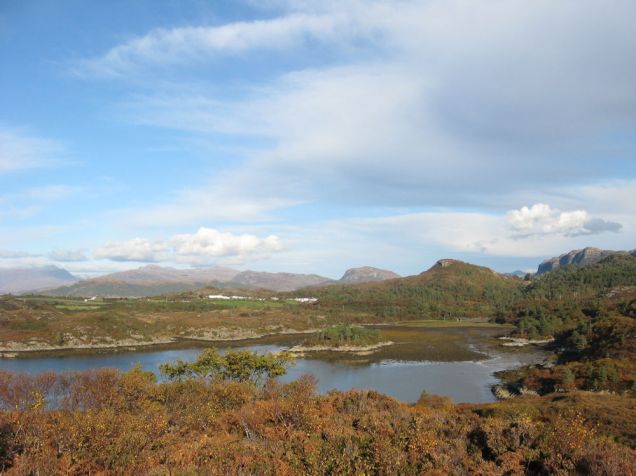 One does not have to get very far from Kyleakin to do quite a good deal of exploring. The varied array of views and multitudes of snug, hidden locations mean that clawing repeatedly over a few square miles is not actually that repetitive. This is a bay south-west of Plockton, between there and Duirinish. Plockton is the other notable centre of population on the Kyle line apart from Kyle of Lochalsh and about half a dozen miles up the coast at the entrance to Loch Carron. Scottish land law does not acknowledge public footpaths, instead declaring the entire country to be (within general good reason) open access. This allows for a great deal of tramping through heather before deciding that perhaps the concept is not necessarily as all-freeing as it might be. Still, it allows for a certain variety of views and a part of this one graces the cover of a notebook that I wander around with for jotting down thoughts and inspirations – or failing that email addresses for people I might want to get hold of again, rules for card games, locations of handy takeaways for the list and other such things.
One does not have to get very far from Kyleakin to do quite a good deal of exploring. The varied array of views and multitudes of snug, hidden locations mean that clawing repeatedly over a few square miles is not actually that repetitive. This is a bay south-west of Plockton, between there and Duirinish. Plockton is the other notable centre of population on the Kyle line apart from Kyle of Lochalsh and about half a dozen miles up the coast at the entrance to Loch Carron. Scottish land law does not acknowledge public footpaths, instead declaring the entire country to be (within general good reason) open access. This allows for a great deal of tramping through heather before deciding that perhaps the concept is not necessarily as all-freeing as it might be. Still, it allows for a certain variety of views and a part of this one graces the cover of a notebook that I wander around with for jotting down thoughts and inspirations – or failing that email addresses for people I might want to get hold of again, rules for card games, locations of handy takeaways for the list and other such things.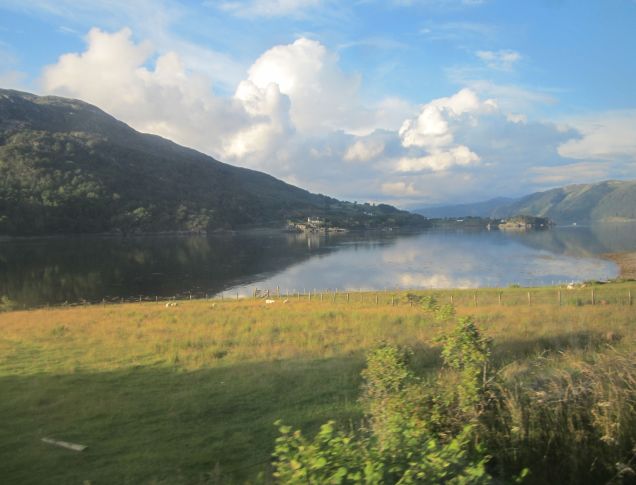 When it’s not late at night in October (for example, when it’s mid-evening in mid-summer), the Kyle line is generally agreed to be worth the trip to Kyleakin in itself. Personally I advise against doing out-and-back runs of any of the rural Scottish lines in a day with intention of viewing the scenery, as it will start to wear after a while. Much better to spend a few days enjoying being at the end of the line, but the journey by train from Inverness is the sort of journey which makes it worth leaving the car at home and skipping the bus options.
When it’s not late at night in October (for example, when it’s mid-evening in mid-summer), the Kyle line is generally agreed to be worth the trip to Kyleakin in itself. Personally I advise against doing out-and-back runs of any of the rural Scottish lines in a day with intention of viewing the scenery, as it will start to wear after a while. Much better to spend a few days enjoying being at the end of the line, but the journey by train from Inverness is the sort of journey which makes it worth leaving the car at home and skipping the bus options. The train also serves such wonderful places as Strome Ferry. Strome Ferry was largely created by the railway as the original terminus, the Kyle extension being stupendously expensive for reasons most readily explained by travelling on it. Strome Ferry thus got to be the centre of 19th-century campaigns to preserve the Sabbath from desecration by railway companies that wanted to take the Saturday fishing catch to London on a Sunday. Otherwise the attractions of Strome Ferry are largely summarised by this (faintly iconic) road sign.
The train also serves such wonderful places as Strome Ferry. Strome Ferry was largely created by the railway as the original terminus, the Kyle extension being stupendously expensive for reasons most readily explained by travelling on it. Strome Ferry thus got to be the centre of 19th-century campaigns to preserve the Sabbath from desecration by railway companies that wanted to take the Saturday fishing catch to London on a Sunday. Otherwise the attractions of Strome Ferry are largely summarised by this (faintly iconic) road sign.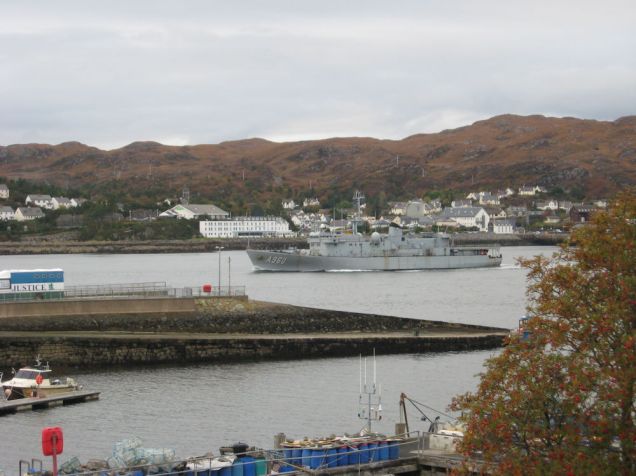 The Royal Navy on manoeuvres past Kyleakin, seen from South Obbe. The minibus on the pier is sat at left. This particular piece of Navy kit managed to navigate Caol Acain without wrecking itself on anything. Beyond is Kyle of Lochalsh, with the large form of the Lochalsh hotel above the ship’s bows.
The Royal Navy on manoeuvres past Kyleakin, seen from South Obbe. The minibus on the pier is sat at left. This particular piece of Navy kit managed to navigate Caol Acain without wrecking itself on anything. Beyond is Kyle of Lochalsh, with the large form of the Lochalsh hotel above the ship’s bows. Kyleakin also has a twin-peaked mountain of its own, the higher bit of which is called Sgurr na Coinnich. It is a pathless mountain which rises squarely from sea level behind Kyleakin to a height of 739m in about 2 miles (3km – an average gradient of about 1 in 4). For those who can be bothered to clamber over the heather and patches of bog all the way to the top, the views are no doubt rather good. For those (like me) who get bored three-quarters of the way up, there are still some handsome views of the Red Cuillins, the rest of Skye stretching northwards, the Applecross Peninsular (pictured), the bridge, Kyle of Lochalsh town and station and, tucked against the south face of the Kyle of Loch Alsh, the village of Kyleakin itself. Clouds streak close overhead and helicopters chatter past below on their way down the loch. Looking down at the right time will provide very distant views of the little Class 158s bringing a few more people across from Inverness to the area – from shopping, for holidays, for walks or for a cup of tea at the Lochalsh hotel before heading east again.
Kyleakin also has a twin-peaked mountain of its own, the higher bit of which is called Sgurr na Coinnich. It is a pathless mountain which rises squarely from sea level behind Kyleakin to a height of 739m in about 2 miles (3km – an average gradient of about 1 in 4). For those who can be bothered to clamber over the heather and patches of bog all the way to the top, the views are no doubt rather good. For those (like me) who get bored three-quarters of the way up, there are still some handsome views of the Red Cuillins, the rest of Skye stretching northwards, the Applecross Peninsular (pictured), the bridge, Kyle of Lochalsh town and station and, tucked against the south face of the Kyle of Loch Alsh, the village of Kyleakin itself. Clouds streak close overhead and helicopters chatter past below on their way down the loch. Looking down at the right time will provide very distant views of the little Class 158s bringing a few more people across from Inverness to the area – from shopping, for holidays, for walks or for a cup of tea at the Lochalsh hotel before heading east again.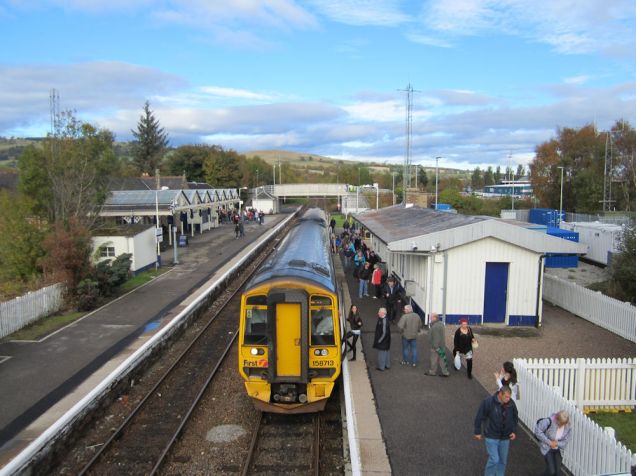 Rather than strike straight back South, I took three nights in Thurso after doing Skye. This meant changing at Dingwall for a Far North train. 158713 is seen with the lunchtime train from Kyle, back in civilisation and preparing to do the Inverness metro run through Muir of Ord and Beauly to the Highland capital. A few moments later 158714 slid in alongside with the mid-afternoon Inverness – Kyle service. The junction is at the north end of the station beyond the bridge. Kyle to Thurso on this set of connections takes 5¾ hours, of which ½-hour is spent at Dingwall and the rest chattering along in 158s at up to 75mph. (The 75 is on the Far North route, which has been upgraded to broadly mainline status, albeit single track. The Kyle line has jointed track and a limit of 45. The investment in keeping the Far North Mainline fast is worth it, despite the minimal population; it is a sobering thought that Inverness is less than two-thirds of the way between Edinburgh and Thurso.)
Rather than strike straight back South, I took three nights in Thurso after doing Skye. This meant changing at Dingwall for a Far North train. 158713 is seen with the lunchtime train from Kyle, back in civilisation and preparing to do the Inverness metro run through Muir of Ord and Beauly to the Highland capital. A few moments later 158714 slid in alongside with the mid-afternoon Inverness – Kyle service. The junction is at the north end of the station beyond the bridge. Kyle to Thurso on this set of connections takes 5¾ hours, of which ½-hour is spent at Dingwall and the rest chattering along in 158s at up to 75mph. (The 75 is on the Far North route, which has been upgraded to broadly mainline status, albeit single track. The Kyle line has jointed track and a limit of 45. The investment in keeping the Far North Mainline fast is worth it, despite the minimal population; it is a sobering thought that Inverness is less than two-thirds of the way between Edinburgh and Thurso.) The Far North is not Skye, but it is really worth a visit. One of the least densely-populated regions in Europe, there is nowhere else quite like it in Britain. The main road from Forsinard (which consists of a railway station and a hotel) is seen heading for the next notable centre of population at Helmsdale, a trifle under 50 miles away to the south. The OS map of the area features about the same mileage of road as railway.
The Far North is not Skye, but it is really worth a visit. One of the least densely-populated regions in Europe, there is nowhere else quite like it in Britain. The main road from Forsinard (which consists of a railway station and a hotel) is seen heading for the next notable centre of population at Helmsdale, a trifle under 50 miles away to the south. The OS map of the area features about the same mileage of road as railway.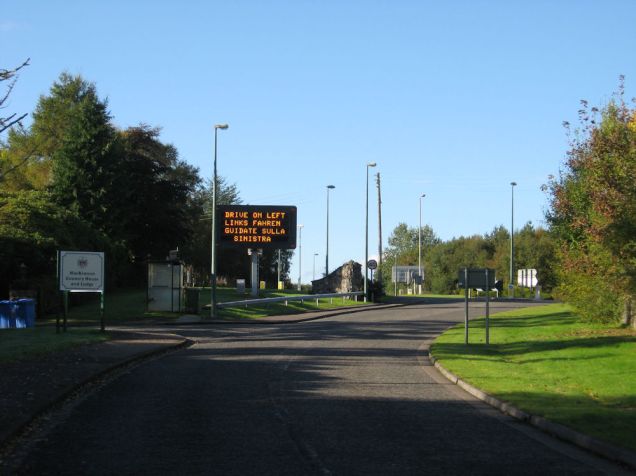 Even fairly casual users of the British road network will be familiar with the “wayside pulpits” which preach valuable information like “don’t drink and drive” in neat LED block capitals and present warnings of queues ahead to the three-mile-tailback behind the latest motorway pile-up. There are also wayside pulpits around the A87, which lacking major traffic events to report upon are obliged to consider other points of note. Drivers coming out of the Port of Kyleakin onto the A87 are therefore confronted with this sign. As the Port of Kyleakin consists of the derelict slipway for a ferry remarked on above, exactly what traffic is expected to emanate from Kyleakin that is unfamiliar with basic British road usage is unclear. If this is all the pulpit has to say one wonders what the business case for it was. Anyway, this is what Skye wayside pulpits preach on.
Even fairly casual users of the British road network will be familiar with the “wayside pulpits” which preach valuable information like “don’t drink and drive” in neat LED block capitals and present warnings of queues ahead to the three-mile-tailback behind the latest motorway pile-up. There are also wayside pulpits around the A87, which lacking major traffic events to report upon are obliged to consider other points of note. Drivers coming out of the Port of Kyleakin onto the A87 are therefore confronted with this sign. As the Port of Kyleakin consists of the derelict slipway for a ferry remarked on above, exactly what traffic is expected to emanate from Kyleakin that is unfamiliar with basic British road usage is unclear. If this is all the pulpit has to say one wonders what the business case for it was. Anyway, this is what Skye wayside pulpits preach on.